

Socket clients and servers CSCI 136: Fundamentals of Computer Science II • Keith Vertanen
Overview • Networking basics – IP Addresses (review) – Port numbers (review) – Reliability, connecting, latency, firewalls • Single threaded examples – Magic-8 ball (from last time) – Magic-8 ball persistent • Multi-threaded servers – Magic-8 ball multi-threaded server – Shared key/value server 2
Client1 @ 192.168.1.100 Server @ 150.131.202.152 katie.mtech.edu % java Magic8Client 150.131.202.152 5000 Client2 @ 192.168.1.110 % java Magic8Server 5000 % java ValueClient katie.mtech.edu 6000 Client3 @ 192.168.1.120 % java ValueServer 6000 % java ValueClient Thread 1 150.131.202.152 6000 Thread 2 3
Communication reliability • Socket communication protocol: – We'll use TCP (Transmission Control Protocol) – TCP/IP = TCP over IP (Internet Protocol) – IP protocol: • De facto standard for Internet communication • But: only provides "best effort" delivery – Messages may or may not get there – Messages may get reordered in transit – Luckily: TCP provides reliable in-order delivery • You can be sure what you read/write will get there (unless something really bad happens) 4
Establishing a connection • Starting a socket connection: – 3-way handshake – Connection takes a bit to startup – Keep around if you have an ongoing conversation Client Server 5
Latency • Signals can only go so fast: Medium Speed of light 3.0 x 10 8 m/s Vacuum 2.3 x 10 8 m/s Copper cable 2.0 x 10 8 m/s Optical fiber http://xkcd.com/723/ 6
Latency • latency = propagation + transmit + queue • propagation = distance / speed of light • transmit = size / bandwidth latency propagation transmit queue Queuing delays More important for More important for inside the network, long messages, short messages, bits e.g. processing by a getting the bits on only go as fast as router the wire speed of light 7
Firewalls • Network hardware/software may interfere – e.g. Hosts on the same network but traffic blocked for certain port numbers Keith's laptop 10.1.20.100 % java Magic8Server 5000 katie.mtech.edu 150.131.202.152 William's laptop % java Magic8Server 5000 10.1.20.101 This failed, wireless access point (AP) blocked attempt to connect % java Magic8Client 10.1.20.100 5000 to port 5000 on 10.1.20.100 8
Handy network utilities • ping <hostname or IP address> – Test if you can reach the destination • Time for a tiny message to go there and come back – Round Trip Time (RTT) • Note: some hosts may disable responding to pings % ping keithv.com Pinging keithv.com [69.164.194.211] with 32 bytes of data: % ping katie.mtech.edu Reply from 69.164.194.211: bytes=32 time=123ms TTL=44 % ping bbc.co.uk Reply from 69.164.194.211: bytes=32 time=123ms TTL=44 Pinging katie.mtech.edu [150.131.202.152] with 32 bytes of data: Reply from 69.164.194.211: bytes=32 time=121ms TTL=44 Request timed out. Pinging bbc.co.uk [212.58.241.131] with 32 bytes of data: Reply from 69.164.194.211: bytes=32 time=119ms TTL=44 Request timed out. Reply from 212.58.241.131: bytes=32 time=162ms TTL=229 Request timed out. Reply from 212.58.241.131: bytes=32 time=160ms TTL=229 Ping statistics for 69.164.194.211: Request timed out. Reply from 212.58.241.131: bytes=32 time=162ms TTL=229 Packets: Sent = 4, Received = 4, Lost = 0 (0% loss), Reply from 212.58.241.131: bytes=32 time=163ms TTL=229 Approximate round trip times in milli-seconds: Ping statistics for 150.131.202.152: Minimum = 119ms, Maximum = 123ms, Average = 121ms Packets: Sent = 4, Received = 0, Lost = 4 (100% loss), Ping statistics for 212.58.241.131: Packets: Sent = 4, Received = 4, Lost = 0 (0% loss), Approximate round trip times in milli-seconds: Minimum = 160ms, Maximum = 163ms, Average = 161ms 9
Handy network utilities • ipconfig (Windows), ifconfig (Mac/unix) – Find out your wired/wireless IP address c:\ipconfig Windows IP Configuration Ethernet adapter Local Area Connection: Connection-specific DNS Suffix . : passcall Link-local IPv6 Address . . . . . : fe80::615f:559:cfb6:8d35%10 IPv4 Address. . . . . . . . . . . : 192.168.1.6 Subnet Mask . . . . . . . . . . . : 255.255.255.0 Default Gateway . . . . . . . . . : 192.168.1.1 10
Magic 8 ball: Internet Edition • Server: – keithv.com , public IP address – Running on port 587 • To make it past Tech's wireless firewall – Delivering 1 of 20 messages – Services a single client at a time • Client(s): – My laptop on the wireless network – Your laptop on the wireless network – Private IP address – Displays message from the server 11
Magic 8 ball: Persistent connections • Original version: One prediction per connection • Persistent version: – A protocol between client and server Client Server Wait for client Make connection to server Send name of user Send first fortune Receive first fortune Send "MORE" Receive command "MORE" Send second fortune Receive second fortune Send "QUIT" Close socket Receive command "QUIT" Close socket 12
Magic 8 ball: Multi-threaded server • Problem with persistent version: – One client can hog the 8-ball for a long time • Multi-threaded server: – Spawn a thread to handle each client – Server's main thread can then wait for a new client 13
Programming activity • Create a client to GET/PUT values on server – Connect to my server: • keithv.com , port 587 – Server stores a shared HashMap , (key, value) pairs – Client reads a line in from StdIn – Protocol: • Client sends a request : • Server returns a response : GET <key> RESULT <key> <value> PUT <key> <value> OK / ERROR PRINT List of (key, value) pairs QUIT 14
Summary • Networking and sockets – IP addresses, port numbers – Getting connected: • Setup expense • Firewall problems – Message delivery is: • Reliable in-order (at least how we're currently doing it) • Incurs some latency to travel over the interpipes • Building socket client/servers – One-hit wonder versus persistent interaction – Single-threaded versus multi-threaded server 15
Recommend
More recommend